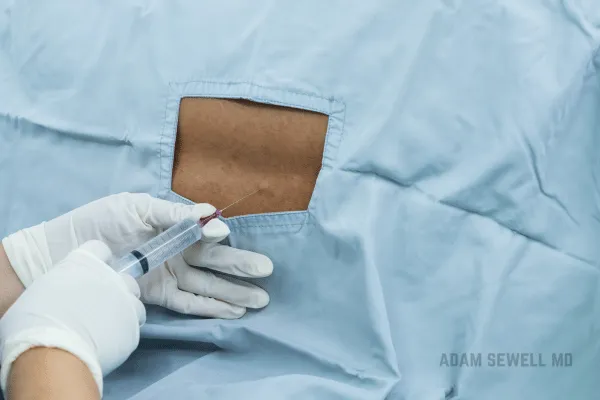Adam Sewell, M.D.
RESOURCES

CONTINUOUS CATHETER NERVE BLOCKS
Continuous peripheral nerve infusions involve inserting a small catheter under the skin, near a peripheral nerve in order to provide a continuous supply of an analgesic medication for pain relief (Ilfeld 2005). The conditions mostly likely to benefit from this treatment are post-operative surgical pain and Complex Regional Pain Syndrome or RSD (Dadure 2005). Our physicians are experienced in offering these techniques as an innovative means of pain management. Although most often used in treating post-operative surgical pain and RSD, the following conditions also benefit –
Procedure:
It, generally, takes less than 15 minutes to place the catheters. Your physician will first cleanse the skin and, under some circumstances, provide IV sedation. Then local anesthetic is applied, and a needle is placed through the anesthetized tissue. Using nerve stimulation with twitch-monitor or ultrasound guidance, your physician will place the needle next to the irritated nerve. The catheter is, then, manipulated in place and the needle withdrawn. The catheter remains, delivering much needed pain medication to the area. The catheter will be secured with adhesive and a bandage, and the catheter is maintained in a carrying pouch, about the size of a softball. This pouch holds the medication, providing a constant stream of pain management for 5 to 7 days, after which time, it will be removed.
Benefits:
Patients who received continuous infusion local anesthetic were much less likely to experience breakthrough pain when compared those who managed pain through oral analgesics only (Ilfeld 2005). Oral opioids come with their own collection of side effects, some serious, so those who are able to utilize another pain management source, do not have the pharmacological side effects of oral pain medications as well. If the affected nerves are severely and regularly irritated, a continuous infusion may provide prolonged pain relief.
Risks:
Most continuous catheter placements are performed on an outpatient basis with minimal risks. However, as expected with any procedure, there are associated risks. With continuous catheters the risks are bleeding, infection, inadequate pain surface area coverage, and nerve injury (Ilfeld 2007). The catheter site must be kept dry and clean while healing in order to avoid infection. While the catheter site is healing it is important to keep it dry and clean so an infection does not occur. If there is any drainage or redness at the site, you’ll need to contact your doctor immediately.
Outcome:
A 2006 study revealed that a group of patients recovering from knee surgery, receiving continuous catheter infusion, healed faster than those using oral or intravenous opiates after surgery. Their recovery time was shorter and rehabilitation time more effective. (Ruyter 2006). In several other large studies, involving both adults and pediatric patients, continuous catheter infusion resulted in excellent pain management solutions for a myriad of chronic pain issues (Singelyn 2005).
Journal Articles:
Ambulatory Perineural Local Anesthetic Infusion. Ilfeld, Brian; University of Arkansas, Gainesville. 4th Regional Anesthesia Int’l Symposium Oct. 11, 2002 Continuous Peripheral Nerve Blocks for Patients at Home Brian M. Ilfeld, M.D. F. Kayser Enneking, M.D. American Society of Anesthesiologists May 2005
A pilot study on continuous femoral perineural catheter for analgesia after total knee arthroplasty: the effect on physical rehabilitation and outcomes. De Ruyter ML, Brueilly KE, Harrison BA, Greengrass RA, Putzke JD, Brodersen MP. J Arthroplasty. 2006 Dec;21(8):1111- 7. Epub 2006 Jun 21
Continuous peripheral nerve blocks at home for treatment of recurrent complex regional pain syndrome I in children. Dadure C, Motais F, Ricard C, Raux O, Troncin R, Capdevila X. Anesthesiology. 2005 Feb;102(2):252-5.
Effects of intravenous patient-controlled analgesia with morphine, continuous epidural analgesia, and continuous femoral nerve sheath block on rehabilitation after unilateral total-hip arthroplasty. Singelyn FJ, Ferrant T, Malisse MF, Joris D. Reg Anesth Pain Med. 2005 Sep-Oct;30(5):452-
Why Choose Adam Sewell, M.D.?
we believe in treating the whole person, not just the symptoms. Our approach to medicine is integrative, combining the best of modern science with personalized care to deliver real, lasting results. We work closely with each patient to develop a customized treatment plan that aligns with their health goals and lifestyle.
Patient-Centered Care
We listen to your concerns, understand your goals, and work with you to create a treatment plan that's right for you.
Advanced Technology
We utilize the latest medical technologies and techniques to provide you with the most effective treatments available.
Expertise You Can Trust
Dr. Adam Sewell is a triple board-certified physician with a passion for helping patients achieve their best health. His expertise in regenerative medicine, hormone therapy, and performance medicine ensures that you're in capable hands.
Comprehensive Health Solutions
From gut health to cognitive function, joint regeneration to hormone optimization, our services are designed to address every aspect of your health.

Ready to Take the Next Step?
If you're ready to transform your health and live your best life, we're here to help. Contact us today to schedule a consultation and discover how Adam Sewell, M.D. can help you achieve your health goals.
Contact Us
Please feel free to reach out to us at adam@adamsewellmd.com or kindly complete the form. Rest assured, we will respond to your inquiry at the earliest opportunity.
Our Locations
By providing my phone number, I agree to receive text messages from the business.

Copyright © 2025
Adam Sewell M.D., All rights reserved.